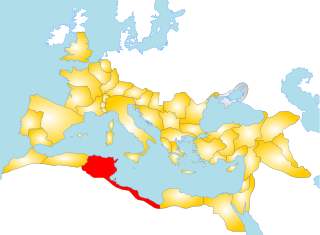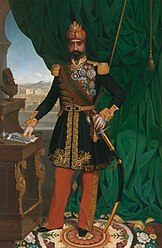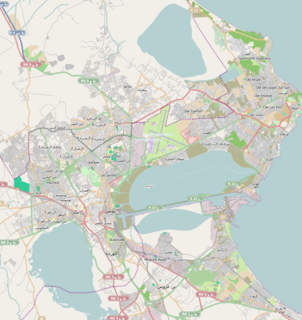
Dar Ibn Abi Dhiaf is a palace in the medina of Tunis, located near the Pasha Street and Sidi Mahrez Mosque, in the Ibn Abi Diaf dead end.

Dar Ibn Abi Dhiaf is a palace in the medina of Tunis, located near the Pasha Street and Sidi Mahrez Mosque, in the Ibn Abi Diaf dead end.

The palace was built by the minister Ahmad ibn Abi Diyaf in the 19th century. [1]

Tunis is the capital and largest city of Tunisia. The greater metropolitan area of Tunis, often referred to as "Grand Tunis", has about 2,700,000 inhabitants. As of 2020, it is the fourth-largest city in the Maghreb region and the sixteenth-largest in the Arab world.

Ifriqiya, known professionally as el-Maghrib el-Adna, was the area during medieval history comprising Constantinois and Aurès, Tunis and Tripolitania — all part of what had previously been included in the Africa Province of the Roman Empire.

Muhammad III as-Sadiq GCB was the Husainid Bey of Tunis from 1859 until his death. Invested as Bey al-Mahalla on 10 June 1855, he succeeded his brother Muhammad II ibn al-Husayn on 23 September 1859. Named as divisional General in the Imperial Ottoman Army on 10 June 1855, he was promoted to the rank of Marshal on 10 December 1859.

The Alids are an Arab community, found predominantly in the Arab world and the South Asian countries. Alids are the one who were accepted as the descendants of Caliph Ali ibn Abi Talib, cousin and son-in-law of Islamic prophet Muhammad, through all his wives.

Ahmed I, born 2 December 1805 in Tunis died May 1855 at La Goulette, was the tenth Husainid Bey of Tunis, ruling from 1837 until his death. He was responsible for the abolition of slavery in Tunisia in 1846.

Mohammed Bey or M'hamed Bey, was the eleventh Husainid Bey of Tunis, ruling from 1855 until his death. He was the son of Al-Husayn II ibn Mahmud and his second wife Lalla Fatima al-Munastiri.
Ibn al-Qūṭiyya, born Muḥammad Ibn ʿUmar Ibn ʿAbd al-ʿAzīz ibn ʾIbrāhīm ibn ʿIsā ibn Muzāḥim, also known as Abu Bakr or al-Qurtubi, was an Andalusian historian and the greatest philologist at the Umayyad court of caliph Al-Hakam II. His magnum opus, the History of the Conquest of al-Andalus, is one of the earliest Arabic Muslim accounts of the Islamic conquest of Spain.
Ilyas ibn Habib al-Fihri was an Arab noble of the Oqbid or Fihrid family, and briefly ruler of Ifriqiya in 755.

The Medina of Tunis is the medina quarter of Tunis, the capital of Tunisia. It has been a UNESCO World Heritage Site since 1979.

Bab Bhar Mosque, also known as Ez-Zraariâ Mosque is a mosque in Tunis, Tunisia.
Mohamed Bey El Mouradi was a Muradid leader and Bey of Tunis from 1686 until his death. He was the eldest son of Murad II Bey.
Hammuda Pasha Bey, died 1666 was the second Bey of the Tunisian Muradid dynasty. He reigned from 1631 until his death.

Ahmad ibn Abi Diyaf, known colloquially as Bin Diyaf, was the author of a chronicle of Tunisian history; he was also a long-time and trusted official in the Beylical government of Tunisia. His multi-volume history, while it begins with the 7th-century arrival of the Arabs, devotes the most attention to details of the Husainid dynasty (1705–1957), during the 18th and 19th centuries. His writing is informed by his experience as chancellery secretary during the reigns of five Beys in succession. Bin Diyaf himself eventually favored the reform view, which was current then in Tunisian politics. His letter in reply to questions about Tunisian women has also attracted interest.
Abu Muhammad Rashid al-Shakir Sahib al-Taba'a, born around 1790 and died 11 September 1837 at Le Bardo, was a Tunisian politician of Circassian origin.
Murad Bey, died 1631 was the first hereditary bey of Tunis, founder of the Muradid dynasty. He reigned from 1613 until his death.
Mourad II Bey, died 1675 in the palace of Bardo was the third Muradid Bey of Tunis from 1666 until his death.
Ibrahim Sharif was Bey of Tunis from 1702 to 1705, during the period of crisis which brought an end to the Muradid dynasty and preceded the rise to power of Husayn I Bey.
Uthman Dey or Kara Osman Dey was Dey of Tunis from 1593 until his death.

Carthage is a commune in Tunis Governorate, Tunisia. It is named for, and includes in its area, the archaeological site of Carthage.

Dar Zarrouk is one of the palaces of the old town of Tunis. It is one of the largest historical palaces in Tunis.